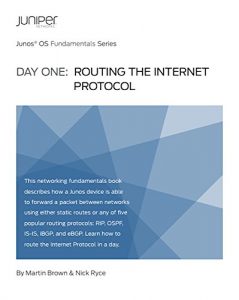This networking fundamentals book describes how a Junos device is able to forward a packet between networks using either static routes or any of five popular routing protocols: RIP, OSPF, IS-IS, iBGP, and eBGP. Learn how to route the Internet Protocol in a day.
This book is intended for network engineers who have either just begun their career in network engineering or have worked in an environment where only one routing protocol was used, so they are unfamiliar with the other routing protocols in the Junos OS.
If you are familiar with how the Junos CLI works, you can follow along with how to configure not only static routing, but the popular routing protocols: RIP, OSPF, IS-IS, iBGP, and eBGP. This book discusses each routing protocol’s unique traits and then shows you how to implement them in the Junos OS for any Juniper Networks device.
The authors, both Juniper Ambassadors, draw from their many years of network administration to provide examples and configuration samples that you will likely enounter in real-world networks.
“The network industry is undergoing a revolution whereby the boundaries between server and network engineer are becoming blurred. Now, more than ever before, it is important for all to have a good grounding in the fundamentals of routing. This Day One book on the fundamentals of routing from Martin Brown and Nick Ryce, along with the entire Day One library as a whole, fills that gap.” - Perry Young, Senior VP, Cyber Security Ops, undisclosed firm, JNCIP-SEC/SP/ENT
IT’S DAY ONE AND YOU HAVE A JOB TO DO, SO LEARN HOW TO:
• Better understand the different interior gateway protocols
• Know the differences between Distance Vector, Path Vector, and Link State protocols
• Understand how Administrative Distance affects routing to a subnet
• Be able to build a more scalable network topology
• See how this information relates to a live network
About the Authors
Martin Brown is a Network Security Engineer for a major telco based in the UK, and a Juniper Ambassador with knowledge that covers a broad range of network devices. Martin started his career in IT 20 years ago supporting Macintosh computers, became an MCSE in 1999, and has since progressed to networking, supporting most of the major manufacturers including Cisco, F5, Checkpoint, and of course, Juniper.
Nick Ryce is a Senior Network Architect for a major ISP based in Scotland, and a Juniper Ambassador. Nick has over a decade of experience working within the Service Provider industry and has worked with a variety of vendors including Cisco, Nortel, HP, and Juniper. Nick is currently certified as JNCIE-ENT #232.
This book is intended for network engineers who have either just begun their career in network engineering or have worked in an environment where only one routing protocol was used, so they are unfamiliar with the other routing protocols in the Junos OS.
If you are familiar with how the Junos CLI works, you can follow along with how to configure not only static routing, but the popular routing protocols: RIP, OSPF, IS-IS, iBGP, and eBGP. This book discusses each routing protocol’s unique traits and then shows you how to implement them in the Junos OS for any Juniper Networks device.
The authors, both Juniper Ambassadors, draw from their many years of network administration to provide examples and configuration samples that you will likely enounter in real-world networks.
“The network industry is undergoing a revolution whereby the boundaries between server and network engineer are becoming blurred. Now, more than ever before, it is important for all to have a good grounding in the fundamentals of routing. This Day One book on the fundamentals of routing from Martin Brown and Nick Ryce, along with the entire Day One library as a whole, fills that gap.” - Perry Young, Senior VP, Cyber Security Ops, undisclosed firm, JNCIP-SEC/SP/ENT
IT’S DAY ONE AND YOU HAVE A JOB TO DO, SO LEARN HOW TO:
• Better understand the different interior gateway protocols
• Know the differences between Distance Vector, Path Vector, and Link State protocols
• Understand how Administrative Distance affects routing to a subnet
• Be able to build a more scalable network topology
• See how this information relates to a live network
About the Authors
Martin Brown is a Network Security Engineer for a major telco based in the UK, and a Juniper Ambassador with knowledge that covers a broad range of network devices. Martin started his career in IT 20 years ago supporting Macintosh computers, became an MCSE in 1999, and has since progressed to networking, supporting most of the major manufacturers including Cisco, F5, Checkpoint, and of course, Juniper.
Nick Ryce is a Senior Network Architect for a major ISP based in Scotland, and a Juniper Ambassador. Nick has over a decade of experience working within the Service Provider industry and has worked with a variety of vendors including Cisco, Nortel, HP, and Juniper. Nick is currently certified as JNCIE-ENT #232.






